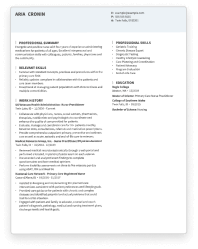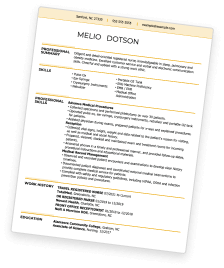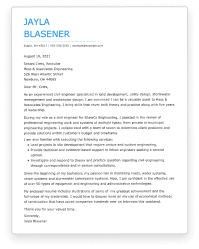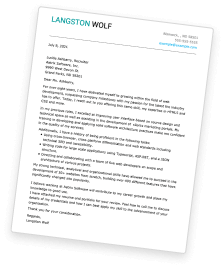Web Designer Resumes: Overview
As a web designer, you are instrumental in crafting the visual and interactive aspects of websites, ensuring they are not only appealing but also user-friendly.
Your role encompasses a wide range of responsibilities, from conceptualizing creative designs and layouts to implementing technical web development elements.
Your expertise might be applied in various settings, including:
- Digital Marketing Agencies
- Tech Startups
- Freelance Web Design
- Corporate IT Departments
- E-commerce Companies
Building an outstanding resume is crucial to landing your next web design role, showcasing your unique blend of design sensibility and technical skills.
Our curated examples and downloadable templates are designed to highlight your ability to create compelling online experiences, helping you stand out in a competitive field.
Web Designer Resume: Choose A Format
Crafting a web designer resume starts with selecting the appropriate template and format.
It’s essential to pick a resume format that not only showcases your creative skills but also highlights your technical proficiency, making you a standout candidate in a field that values both aesthetics and functionality.
There are three primary resume formats web designers can utilize: chronological, functional, and combination.
Chronological Resumes For Web Designers
The chronological resume format is highly recommended for web designers with a strong history of relevant work experience.
This format lists your professional experiences in reverse chronological order, emphasizing your career progression and achievements in the web design field.
For each position, you should include:
- Job Title and Company: Specify your role and the employer.
- Dates of Employment: The timeframe you were employed in each role.
- Responsibilities and Achievements: Use bullet points to detail your duties and highlight significant contributions. Focus on achievements that demonstrate your design skills, technical knowledge, and ability to drive user engagement.
Incorporate strong action verbs and quantify your achievements when possible, such as by noting increases in website traffic or conversion rates directly attributable to your design improvements.
This approach not only showcases your capabilities but also makes your resume more ATS-friendly by including relevant keywords and metrics.
Chronological resumes are particularly effective for web designers who can showcase a steady career growth and a consistent history of impactful design projects.
Functional Resumes For Web Designers
Functional resumes focus on the specific skills and abilities of the candidate, making them ideal for individuals who may not have a traditional career path in web design.
This format is particularly useful for those transitioning from another field, recent graduates, or designers who have freelanced or worked on a project basis.
In a functional resume, emphasize:
- Design Skills: Highlight your proficiency in design software, understanding of design principles, and ability to create visually appealing and user-friendly designs.
- Technical Abilities: Detail your skills in HTML, CSS, JavaScript, or any other programming languages relevant to web design and development.
- Project Management: Showcase your experience in leading projects, meeting deadlines, and collaborating with clients or team members.
While functional resumes allow you to showcase your skills without focusing on the chronological order of your jobs, it’s important to remember that some employers and ATS systems may find this format less straightforward.
To mitigate this, include a brief work history section at the end of your resume to provide context for your experiences.
Combination Resumes For Web Designers
The combination resume format offers the best of both worlds, blending the skill-focused approach of the functional resume with the structured career timeline of the chronological resume.
This format is particularly effective for web designers who want to highlight their strong skill set alongside a robust portfolio of projects or employment history.
In a combination resume, start with a detailed skills section that emphasizes both your design and technical abilities.
Follow this with a chronological list of your work experiences, including roles, companies, and dates, but also incorporating bullet points that detail specific projects and achievements.
This format is advantageous for web designers with a mix of freelance, project-based work, and traditional employment, allowing them to showcase a comprehensive skill set and a history of successful design implementations.
Choosing a Format
Selecting the most suitable resume format is a critical step in crafting your web designer resume. The right format will effectively showcase your skills, experience, and the unique qualities you bring to a potential employer.
The chronological format is often recommended for those with a solid track record in web design, as it clearly demonstrates your professional growth and achievements.
However, don’t discount your diverse experiences if your career path has been less straightforward. Many skills from different roles can be highly relevant to web design.
For instance, if you’re a recent graduate with limited direct web design experience, you might have engaged in projects or roles that honed your artistic sensibility, technical skills, or client communication abilities.
It’s all about how you frame your experiences. Clearly articulate how each role has equipped you with skills that translate well into web design. This could include problem-solving, project management, understanding user experience (UX), or technical skills like coding.
Ultimately, the format you choose should reflect where you are in your career and highlight your strongest assets, whether that’s a rich work history, a diverse skill set, or a combination of both.
How To Write A Web Designer Resume
Choosing the right format for your web designer resume is just the beginning.
To effectively showcase your skills and experiences, your resume outline should include five essential sections, with the option to add more if they contribute to your narrative as a web designer.
These five key sections to writing a resume are:
- Contact Information
- Summary or Objective
- Work History
- Skills
- Education
Each of these sections is critical for illustrating your qualifications and setting you apart as a standout candidate in the web design field.
Contact Information
The contact information section should succinctly provide your name, phone number, professional email address, and location (city/town and state).
If applicable, include your LinkedIn profile and a link to your online portfolio or website, showcasing your web design projects.
Your contact information should be prominently displayed at the top of your resume, making it easy for potential employers to reach out to you.
While this section should be noticeable, ensure it doesn’t detract from the content that follows.
Example of Contact Information for a Web Designer Resume:
Alex Johnson
San Francisco, CA
alex.johnson@fake.email.com
(555) 123-4567
LinkedIn: fake.linkedin.com/in/alexjohnsondesign
Portfolio: fake.alexjohnsondesign.com
Maintaining a professional presentation in this section is crucial, as it sets the tone for the rest of your resume.
Summary or Objective
Following your contact information, your web designer resume should feature a section that succinctly introduces you to potential employers, highlighting your unique qualifications and career aspirations.
You can opt for either a resume summary or an objective, depending on your professional experience and goals.
Resume Summary: Ideal for web designers with significant experience, a summary offers a concise overview of your skills, notable projects, and professional achievements. This is an excellent opportunity to showcase your expertise and the value you can bring to a potential employer.
Here’s an example of a good resume summary for a web designer resume:
“Innovative Web Designer with over 8 years of experience specializing in creating visually compelling and user-friendly websites for diverse clients. Expertise in responsive design, with a proven track record of enhancing user experience and engagement. Skilled in Adobe Creative Suite, HTML5, CSS3, and JavaScript. Recognized for delivering projects on time and within budget, contributing to increased client satisfaction and repeat business.”
Resume Objective: More suitable for new graduates, career changers, or those with less experience in web design, an objective focuses on your career goals and how you aim to grow and contribute as a web designer.
Here’s an example of a good resume objective for a web designer resume:
“Creative and technically adept aspiring Web Designer with a strong foundation in graphic design principles and web development tools, seeking to leverage academic background and freelance experience to contribute to the innovative projects at XYZ Digital Agency. Eager to develop engaging, user-centered designs and continue professional growth in web design and UX/UI.”
Whichever approach you choose, tailor this section to include keywords relevant to the web design job you’re applying for.
This not only helps your resume pass through Applicant Tracking Systems but also aligns your profile with the specific needs and goals of your potential employer, increasing your chances of standing out.
Work History
The “Work History” section of your web designer resume is vital for illustrating your professional journey and the specific contributions you’ve made in past roles.
Employers look to this section for evidence of your practical skills, design expertise, and impact on projects or organizations.
Begin with your most recent job and list your experiences in reverse chronological order. Focus on positions that showcase your web design capabilities, but also consider roles that demonstrate complementary skills, such as project management, teamwork, or client relations.
For each position, use action verbs to describe your responsibilities and achievements, and quantify your results whenever possible. This approach not only demonstrates your abilities but also provides measurable proof of your contributions.
Here’s an example of what the work history section on a web designer resume may look like:
Senior Web Designer
Digital Innovations Studio, Chicago, IL
June 2016 – Present
- Spearheaded the redesign of client websites, leading to an average 40% increase in user engagement and a 25% growth in online sales.
- Collaborated with cross-functional teams to ensure the seamless integration of web designs with backend functionalities, enhancing site performance and user experience.
- Managed and mentored a team of junior web designers, fostering a creative environment and improving project delivery times by 30%.
- Conducted user research and A/B testing to inform design decisions, resulting in more intuitive interfaces and user pathways.
- Developed comprehensive brand guidelines for clients, ensuring consistency across all digital and print marketing materials.
In crafting your work history, focus on experiences that highlight your design creativity, technical proficiency, and ability to deliver projects that meet or exceed objectives.
Showcasing a blend of artistic talent and practical web development skills will make your resume more compelling to potential employers.
Skills
The skills section of your web designer resume is where you get to showcase the abilities that make you a strong candidate.
This section should balance your hard skills, including technical skills, with your soft skills, giving a well-rounded view of what you bring to the table.
Although you should always tailor your resume to the web designer job description, here are some of the most popular hard and soft skills to consider for guidance:
Top 5 Hard Skills for Web Designer Resumes
- Responsive Design: Mastery in creating designs that work on desktops, tablets, and mobiles is crucial as the internet becomes increasingly mobile.
- UX/UI Design: Understanding user experience and user interface principles to create intuitive and user-friendly designs.
- Graphic Design Software: Proficiency in tools like Adobe Creative Suite (Photoshop, Illustrator) is essential for crafting visual elements.
- HTML/CSS: Basic knowledge of coding in HTML and CSS to implement your designs directly or work closely with developers.
- SEO Principles: Familiarity with SEO best practices to ensure designs contribute to a site’s visibility on search engines.
Top 5 Soft Skills for Web Designer Resumes
- Creativity: The ability to think outside the box and bring innovative design solutions.
- Communication: Clear communication skills for articulating design concepts and collaborating with team members and clients.
- Problem-Solving: A knack for troubleshooting design or website issues and finding effective solutions.
- Time Management: Managing multiple projects efficiently while meeting deadlines.
- Attention to Detail: A keen eye for detail to ensure every aspect of the website design is perfect.
Here’s an example of what the skills section on a web designer resume might look like:
Skills
- Expert in Adobe Creative Suite for graphic design; proficient in Photoshop and Illustrator
- Experienced in creating responsive designs for optimal mobile and desktop viewing
- Knowledgeable in HTML, CSS, and JavaScript for web development
- Strong understanding of UX/UI design principles to enhance user satisfaction
- Effective communicator with team members and clients to bring visions to life
Not surprisingly, computer skills play a big role in a web designer resume, but don’t discount the importance of interpersonal skills, which help you work as part of a team to accomplish goals.
By listing these skills, you demonstrate not only your capability to design and develop websites but also your ability to work within a team and contribute to a project’s success.
Education
In your web designer resume, the education section details your academic background, which provides the foundation for your design skills and technical knowledge.
List your highest degree first, including the degree type, field of study, institution’s name, location, and graduation date.
You may also highlight relevant coursework, honors, or special recognitions that align with web design.
Given the rapidly evolving nature of web design and technology, it’s beneficial to also mention any continuing education or certifications that keep you at the forefront of design trends and software advancements.
Here’s an example of what an education section on your web design resume could look like:
Bachelor of Fine Arts in Graphic Design
University of California, Los Angeles, CA
Web design roles often value practical skills and a strong portfolio as much as formal education, so while your academic background is important, complementing it with real-world experience and ongoing learning can significantly enhance your resume.
Additional Sections
To further distinguish yourself as a well-rounded candidate, consider including additional sections in your resume.
These can showcase other aspects of your professional or personal development relevant to web design:
- Certifications: Highlight any industry-recognized certifications you’ve earned, such as Adobe Certified Expert (ACE) or Certified Web Professional (CWP), that demonstrate your expertise in specific tools or methodologies.
- Volunteer Experience: Share any volunteer work that involved web design or technology, showing your commitment to using your skills for community benefit.
- Professional Associations: Membership in professional groups like the AIGA (formerly the American Institute of Graphic Arts) or Interaction Design Association (IxDA) can indicate your active engagement with the design community.
- Awards and Honors: Recognitions received for your work or contributions to web design can underscore your talent and dedication.
- Relevant Hobbies: Including hobbies related to technology, design, or art can provide a more complete picture of your interests and creativity.
For example, your resume for web design may have sections that look like this:
Certifications
- Adobe Certified Expert (ACE) in Photoshop CC
- Google UX Design Professional Certificate
Awards and Honors
- Winner, 2020 Web Design Innovation Award, National Web Designers Association
These additional sections can enrich your resume by presenting a fuller picture of your skills, achievements, and character, making you a more attractive candidate for web design roles.
Top 5 Certifications for Web Designers
While not always mandatory, certifications can significantly bolster a web designer’s resume by validating their skills and dedication to their craft. In the dynamic field of web design and development, certain certifications stand out for their ability to enhance your professional profile.
Here are some popular certifications that web designers should consider:
- Adobe Certified Expert (ACE): Adobe’s certification demonstrates your proficiency with Adobe tools, which are standard in the web design industry. Specializing in software like Photoshop, Illustrator, or XD can set you apart.
- Google UX Design Professional Certificate: Offered by Google, this certification highlights your expertise in UX principles, a crucial aspect of web design that focuses on creating a positive and efficient experience for users.
- Certified Web Professional (CWP): This certification acknowledges your ability to design and manage websites effectively, covering everything from HTML and CSS to web graphics and multimedia.
- Responsive Web Design Certification by freeCodeCamp: This certification shows you have the skills to create flexible web pages that look great on any device, a necessity in today’s mobile-first world.
- W3C Front-End Developer Certification: Offered by the World Wide Web Consortium (W3C), this certification proves your knowledge in front-end development, including HTML, CSS, and JavaScript—key skills for any web designer.
11 Tips For Writing a Web Designer Resume
Tailor Your Resume: Adapt your resume for each application to meet the specific needs of the job. Highlight the skills and experiences that match the job description to show you’re the perfect fit.
Use Action Verbs: Begin descriptions of your roles and accomplishments with strong action verbs like “developed,” “designed,” “implemented,” or “optimized” to grab attention and convey your contributions effectively.
Highlight Achievements: Quantify your successes with data whenever possible. For example, mention the percentage increase in website traffic or conversion rates due to your redesign efforts.
Incorporate Keywords: Scan the job posting for keywords and phrases used to describe the desired skills and experiences, then include these in your resume to improve your chances of passing through ATS filters.
Showcase Your Portfolio: Include a link to your online portfolio. It’s essential for employers to see the quality and style of your work firsthand.
Detail Your Design Process: Briefly explain your approach to projects in your work history or summary section to give potential employers insight into how you work.
Technical Proficiencies: Clearly list the design tools, software, and programming languages you’re proficient in, such as Adobe Creative Suite, HTML5, CSS3, JavaScript, and responsive design principles.
Emphasize Soft Skills: Include soft skills like creative thinking, communication, problem-solving, and teamwork, which are crucial for collaborating with clients and team members.
Education and Continuous Learning: Besides your formal education, mention any relevant workshops, online courses, or certifications that demonstrate your commitment to keeping up with industry trends and technologies.
Proofread: A resume free from typos and grammatical errors is crucial in showcasing your attention to detail—a key skill for any web designer.
Social Media Presence: If you’re active on design-focused social media platforms or communities (like Dribbble or Behance), consider including these in your contact information. This can provide further insight into your design philosophy, interests, and ongoing projects.
Helping Job Seekers Like You


Use Hloom's Resume Builder
Key Takeaways
- A web designer’s resume should highlight a balanced mix of creative design abilities and technical competencies, demonstrating your capacity to create visually appealing and functional websites.
- Customizing your resume for each job application, focusing on the specific skills and experiences requested in the job posting, can significantly increase your likelihood of standing out to potential employers.
- Including a link to your online portfolio directly on your resume provides employers with easy access to your work, allowing them to evaluate your design style and capabilities firsthand.
- Emphasizing ongoing education, certifications, and proficiency in the latest web design tools and technologies showcases your commitment to staying current in a rapidly evolving field.
- Highlighting soft skills such as communication and problem-solving, along with a brief insight into your design process, can differentiate you from other candidates by showing how you approach projects and collaborate with teams.
Use Hloom's Cover Letter Builder














